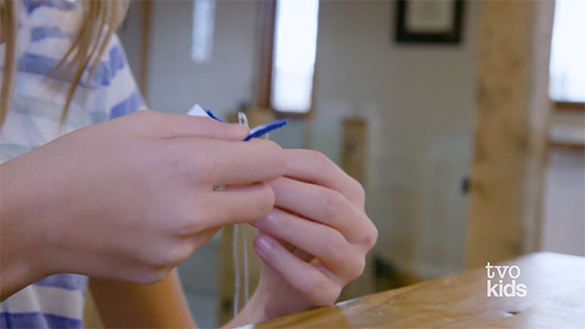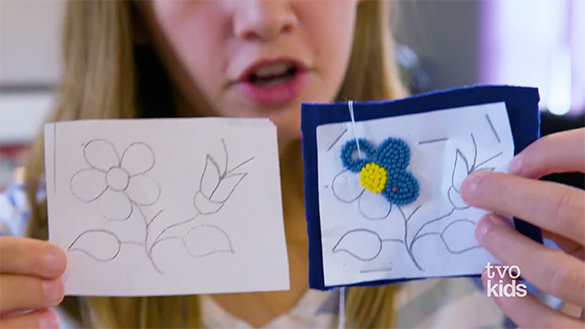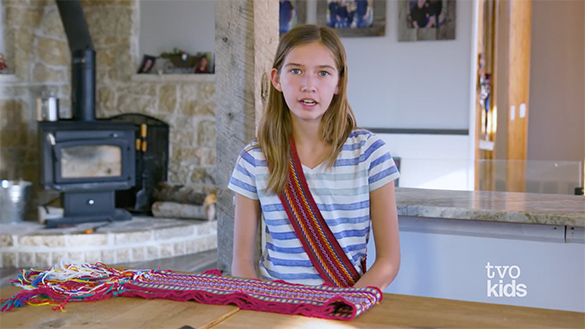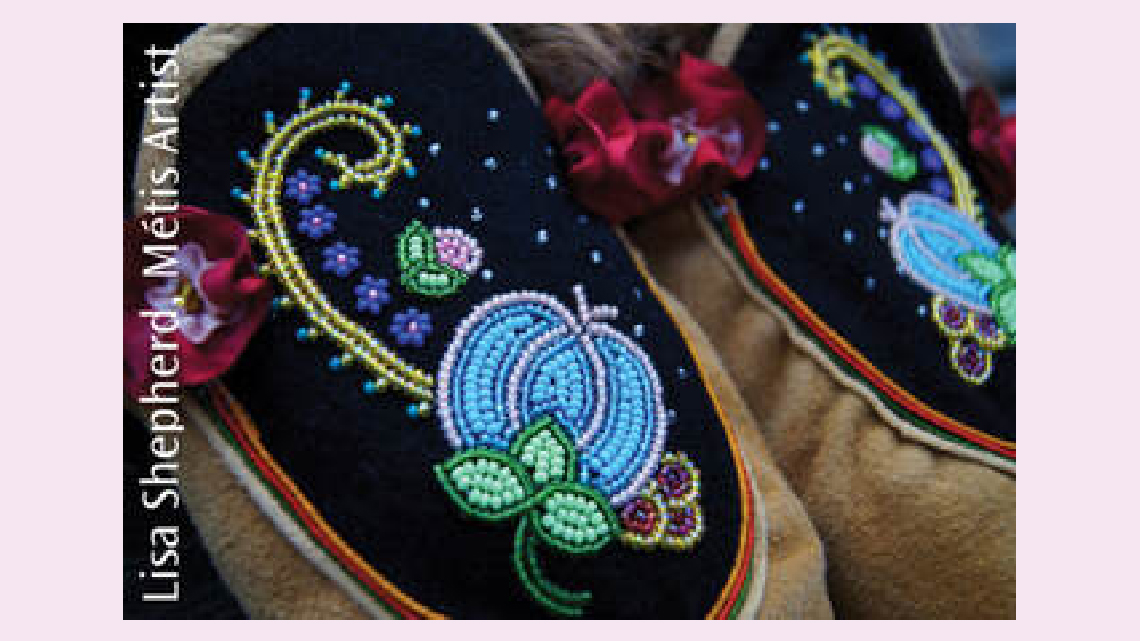Minds On
Let’s get started!
Raven’s Quest
Let’s explore a Raven’s Quest video about Morgan. Morgan is Métis and she is from East Selkirk, Manitoba.
Answer the questions using a method of your choice.
- What does Morgan share in the video?
- What did you learn from Morgan’s story?
Action
Get ready, get set…
Morgan’s story
In the Minds On video, Morgan shares that she is Métis and has learned a particular skill at Métis camp.
Let’s explore the video once again while we think about the following questions.
Why is beadwork important to Morgan?
Press ‘Answer’ to access a possible response to check your answer.
Morgan goes to a Métis camp. She says that it is fun to go because she gets to learn about her culture. Métis beadwork is an important tradition and skill that she has learned from her teachers at camp.
What materials does Morgan bead on? What kind of material is used traditionally?
Press ‘Answer’ to access a possible response to check your answer.

Traditionally, beadwork is done on leather. Morgan uses felt because it is an easier material to bead.
What symbol do you notice is part of Morgan’s beadwork?
Symbol
An image used to represent a thing. An image can represent an idea or an object.
Press ‘Answer’ to access a possible response to check your answer.

Flowers are traditional symbols used in Metis beadwork.
What are the steps Morgan uses to create her beadwork?

Morgan creates an outline of her design. Next, she attaches that to a piece of felt and uses it to help guide her beadwork.
Why is the sash that Morgan wears important? What do the colours included in the sash mean?

Morgan explains that the sash is a Métis sash. She explains that “the colour white represents the connection between us and our earth” and “yellow represents hope and our bright future”.
Did You Know?
Métis culture and sashes
The Métis have worn sashes since the 1700s. It is an important symbol in Métis culture. The sash is also very practical. It can be used to pull canoes, attach a bag of materials to a person’s back, as a dog harness, as a towel or washcloth and even to carry important safety supplies.
Indigenous Peoples Atlas of Canada–Material Culture, Canadian Geographics, URL: https://indigenouspeoplesatlasofcanada.ca/article/material-culture/
Go!
Artist’s spotlight: Lisa Shepherd
As we learned from Morgan’s story, flowers are important symbols in Métis beadwork. Beadwork creates texture, and the intricate floral designs contrast and stand out against a darker background.
Let’s explore some examples of Lisa Shepherd’s artwork.
Lisa Shepherd is a Métis artist whose work reflects Metis culture and tradition. She works together with other members of her community to share knowledge and create understanding through her work.
Portfolio
Contrast and colour
What do you notice about the contrast between the design and the background?
What do you notice about the colours used or the details in the design? Why might both be important?
Contrast
A principle of design. Contrast is the use of opposite kinds of art elements. Contrast can be created by using rough and smooth textures. Contrast can also be created by using dark and light values.
Colours
An element of design. In science, colour is a part of an object when light bounces off it. The four parts of colour are hue, value, intensity, and being warm or cool. Colours can be primary or secondary.
Record your ideas using your art journal or another a method of your choice.
Consolidation
Putting it all together
Your turn

Now that you have learned about floral designs in Metis beadwork, it’s time to create a design in your own style. Indigenous designers traditionally based their beadwork on the plants and animals that they were in their local environment. If you can, explore your area and find different plants and animals that could inspire your work.
Materials Needed
Materials needed
Possible materials you might need for this learning activity:
- a blank sheet of paper or an art journal
- paint
- cotton swabs
- pencil or crayon
Student Success
Exploring digital creation options
When you are considering digital creation options, explore the variety of digital applications available!
Note to teachers: See your teacher guide for collaboration tools, ideas and suggestions.
Safety
Before you begin:
Now it’s your turn to create! Consider the following options to check out a variety of methods to create your art. Choose one option to try out.
Option 1: Description
Create a detailed written or audio description about how you would create your design.
Option 2: Digital design
Use the following frame to create your own. Place dots in the grid to make your own pattern or design. Will you make a flower or tree? Maybe you’d like to make an animal.
Note that this activity is not meant to replicate Dot Art created by Métis artist Christi Belcourt.
Option 3: Materials
The materials you will need for this option are:
- a blank sheet of paper or an art journal
- paint
- cotton swabs
- pencil or crayon
Follow these steps to create your own art inspired by your local environment.
Portfolio
Art portfolio
If possible, share your beautiful art and/or description with a partner! If you have a portfolio, you can put your art there to track your progress over time.
Reflection
How do you feel about what you have learned in this activity? Which of the next four sentences best matches how you are feeling about your learning? Press the button that is beside this sentence.
I feel…
Now, record your ideas about your feelings using a voice recorder, speech-to-text, or writing tool.
Press ‘Discover More’ to extend your skills.
Discover MoreArt traditions
Now that you have learned more about the tradition of Métis beadwork, do you have any art traditions in your family or community?





